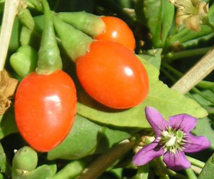Deep in the valleys of the Himalayan mountains of Tibet and Mongolia, there grows a red berry about the size of a small grape… yada, yada, yada…
Read on for the real low down on Goji Berries and Goji Juice.
The Species Debate
Goji berries are a part of a larger family of berries known as Lycium (their Latin name), and most sources indicate that the popular “goji berry” is of the species (Lycium eleganus barbarum), but some may also come from Lycium chinense. Although many botanists do not differentiate between Lycium barbarum, Lycium chinense and Lycium europeaum, my  research indicates that they are in fact distinct. Certain sources claiming that L. barbarum is superior in nutritional content and healing properties may in fact be doing so as a marketing ploy, however. A previous Wikipedia entry for wolfberry notes that the difference between the two varieties is that the L. chinense variety is a shorter bush.
research indicates that they are in fact distinct. Certain sources claiming that L. barbarum is superior in nutritional content and healing properties may in fact be doing so as a marketing ploy, however. A previous Wikipedia entry for wolfberry notes that the difference between the two varieties is that the L. chinense variety is a shorter bush.
The truth is, many of the common goji berries sold on the market may very well differ in genetic makeup, but a more thorough investigation is needed to conclude as to whether one is more nutritious than the others. In fact, the methods used for growing the berries may have just as much to do with their nutritional content. For example, organic fruits and vegetables have been proven to contain significantly higher levels of nutrients and antioxidants.
In conclusion, despite the conflicting information available on the Internet about L. barbarum and L. chinense, primarily, it is known that there are many plants in the Lycium family, some of which contain delicious and quite possibly universally nutritious berries (though you would have to do an analysis to find out).
Buying Goji Juice or Berries
Goji berries and goji juice can now be purchased from a variety of companies, some of which claim to source the berry from its native region of Tibet and Mongolia. Wikipedia, for one, notes that the L. chinense variety of the berry is grown primarily in southern China, and the L. barbarum variety is grown widely in northern China. Whatever the case, most of the berries you get on the market today are grown in China. Although, there are increasing numbers of growers in United States. Many of these berries are also supposedly organically grown (though organic standards in China may be different than North America), but whether or not they are grown in fair trade circumstances (where the workers are paid fair wages) is unknown. Some of the more popular sellers acquire their berries from China, and although some companies claim to get all of their berries from Tibet or Mongolia and tout this as a selling point, it is hard to verify whether all of their berries do come from there, and if in fact it makes any difference.
The Benefits of Goji
Traditionally, in Asian medicine goji berries and goji juice have been used to nurture and strengthen the heart and the immune system, treat insomnia, boost energy, enhance sexual function, improve functioning of the liver, increase visual and auditory receptivity, decrease forgetfulness, lethargy and anxiety and treat chi deficiencies, among other things.
Recently goji berries have been the subject of various scientific studies around the world, including in countries such as Mongolia, Japan, China, Switzerland and the United States. Results of these studies have been published in a number of scientific journals and medical databases. An especially intriguing find regarding Lyceum barbarum is the unique polysaccharides that have been isolated from the berries and used in several experiments. These molecules have been shown to significantly improve resistance to cancer and to have particularly promising anti-aging properties (in the lab!). For more information on these studies, visit the Science of Goji section of this site.
Despite being hailed as a natural healer and anti-aging supplement, the goji berry is also incredibly nutritionally dense and rather delicious. It is eaten commonly both fresh or dried alone, in cooking, cereal, trail mixes, and smoothies. Some people describe its taste as sweet with a slight tartness – somewhat like a cranberry except sweeter. The berries are high in iron, fiber, vitamin C, vitamin E and many other things. It is worth learning about this in more detail in our Nutrition Information section.
So, the question is, is it worth it to buy goji berries or goji juice? There is no doubt that the berries contain high levels of antioxidants, vitamins, minerals, and other beneficial things, but whether or not they are the miracle fruit that many websites say they are is up to you to decide. Explore this website a little further, look at the studies, and decide for yourself.